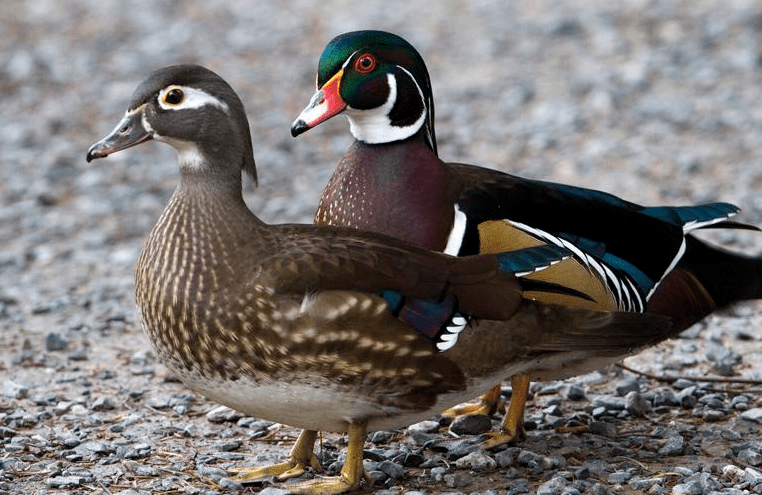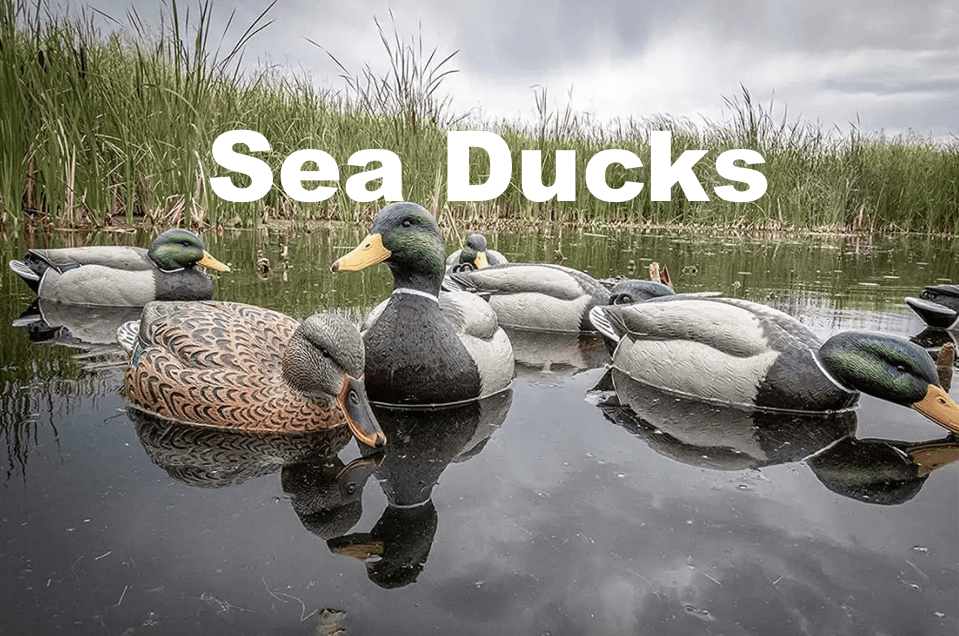This is a guide for the waterfowler’s world for hunting all the Sea Ducks, with essential knowledge you must have as a hunter. If you are a beginner, please come closer and see what you need to know about hunting these magnificent birds.
Hunting sea ducks along the coast of New England can be an exciting adventure, targeting species like long-tailed ducks, common eiders, Atlantic brant, and various scoters.
However, this type of waterfowl hunting comes with unique challenges due to the coastal environment and diverse bird species. Safety should always be a top priority in these conditions.
Related: Difference Between Wood vs. Plastic vs. Acrylic Duck Call
Here are some important considerations for your sea duck hunting adventure:
1. Wind
Captain Ruben Perez’s of ducks.org emphasis on the significance of wind in sea duck hunting is absolutely accurate. Wind conditions play a pivotal role in the safety and success of any coastal waterfowl hunt, particularly for sea ducks. Here are some key points to consider regarding the impact of wind when planning your sea duck hunting expedition:
- Safety should always be the top priority. High winds can create rough seas and unpredictable conditions.
- The choice of boats should align with the anticipated wind conditions.
- Decoys should be strategically positioned to face into the wind, creating a natural presentation for incoming sea ducks.
- Adjust your calling techniques to account for wind noise and to carry your calls effectively to distant birds.
- Depending on the wind direction, you may need to position yourself upwind of your intended hunting area, allowing ducks to approach you against the wind.
- Stay informed about weather conditions leading up to and during your hunt.
2. Tides
“Where I hunt, primarily in Cape Cod Bay and Rhode Island Sound, tides rise or fall 12 feet every six hours,” Perez explains. “Not only do I have to keep sea levels in mind to reach where I want to hunt, I also have to anticipate what the water level will be hours later. In funnel areas, tides can flow like a river, and if you anchor too close to shore, your boat and decoys may not hold.
I prefer to hunt out of layout boats, but strong tidal currents can render them unsafe. And if you hunt with a dog you have to pay particular attention to the tides, waves, and currents.”
Tidal considerations can greatly affect your hunt, so here are some important points to keep in mind:
- Research tide charts for the area where you plan to hunt and become familiar with the timing and magnitude of tides.
- Plann your hunt to coincide with favorable tidal conditions to help make your outing safer and more productive. Avoid hunting in areas with excessive tidal flow if it poses a safety risk.
- While layout boats can be effective for sea duck hunting, their use may be limited or restricted in areas with strong tidal currents. Always put safety first.
3. Location
Sea ducks have a routine. At night, they stay out in the open ocean. Then, during the day, they fly closer to the shore to find food like mussels and small shellfish. Some types of sea ducks, like scoters and long-tailed ducks, like to eat in deeper water, while others, like eiders, don’t mind where they feed, even on the beaches.
“I usually hunt in places where sea ducks like to travel. This way, I don’t have to pick a specific type of sea duck to hunt. I can offer my clients a mix of different ducks,” Perez explains. “But on windy days, I go to protected bays where the ducks find their food. Sea ducks really like small mussels, about the size of your thumbnail. They eat a lot in one area and then move to another when the mussels get too big. So, always keep an eye on where the food is and where each type of sea duck likes to eat.”

4. Boats
The weather and sea can be unpredictable, so Perez suggests using boats that are longer than 20 feet. He personally uses a 26-foot boat. Sometimes, he hunts from this bigger boat when the weather is rough. However, he finds that small layout boats work much better. He uses two layout boats at once and takes turns with four hunters. This way, each hunter has a good chance to spot and shoot the best ducks.
5. Decoys
When hunting sea ducks, it’s important to use large, realistic, and highly visible decoys. According to Perez, these types of decoys are the most effective. Sea ducks are specific about the kinds of ducks they interact with, so if you use decoys for multiple species, it’s a good idea to keep them separated. The choice of decoys also depends on where you’re hunting. For example, in Maine, there are more eiders, so you’ll want eider decoys, while in Rhode Island, scoter and long tail decoys are better.
To set up the decoys, Perez uses long lines with about 15 decoys on each line. Because sea ducks often land a bit away from the decoys, he positions the decoys close to the hunters to ensure they get close shots. Each decoy is attached to the main line with a shorter line that’s about two to three feet long. Perez typically uses just one line of decoys, as using more can make the decoys and shots too far away. Additionally, it’s a safety measure in case bad weather suddenly appears, as it’s quicker to pull in a smaller spread of decoys.
Loads
Sea ducks are known for being fast and resilient. To effectively hunt them, Perez suggests using 3-inch 12-gauge shotgun shells loaded with steel shot size 2s and a modified choke. This combination provides sufficient knockdown power, especially when the birds are within close range.
Trending: Best Duck Calls to Buy Right Now at Amazon for Hunting
Best Hunting Guide for Sea Ducks and other Waterfowler Birds
- Weather Awareness: Coastal hunting is heavily influenced by weather conditions, including wind, waves, and tides. Stay informed about weather forecasts, tide tables, and local conditions before and during your hunt. Sudden weather changes can be dangerous, so be prepared to adjust your plans accordingly.
- Safety Gear: Invest in high-quality safety gear, including life jackets, waders, and flotation devices. Cold water can be extremely hazardous, so dress appropriately for the conditions and wear a personal flotation device (PFD) at all times while on the water.
- Boat and Equipment: Make sure that your boat is seaworthy and well-maintained. Check all safety equipment on board, such as life jackets, flares, a first-aid kit, and a marine radio. It’s essential to have reliable communication tools to call for help in emergencies.
- Navigation Skills: Try to familiarize yourself with the hunting area’s navigation and landmarks. GPS devices and marine charts are valuable tools for staying on course and avoiding hazards like rocks and shoals.
- Local Regulations: You need to understand and adhere to local hunting regulations and bag limits. Sea duck hunting is regulated to protect these species, so know the rules for your specific location.
- Tide Knowledge: Carefully learn about tidal patterns in the area where you plan to hunt. Rising tides can flood hunting areas quickly, so plan your hunt around tidal movements and be aware of changing water levels.
- Experienced Guides: Hunters should consider hiring experienced sea duck hunting guides who are familiar with the area, weather conditions, and bird behavior. They can provide valuable insights and enhance your safety.
- Emergency Plan: As as hunter, you must have a well-defined emergency plan in place. Make sure someone knows your hunting plans and expected return time. Carry a marine radio or cell phone to call for help if needed.
- Firearm Safety: Do not forget to practice firearm safety, especially in a boat. Keep guns pointed in a safe direction, and never load or discharge firearms while the boat is moving or unstable.
- Respect Wildlife: All the ethical hunting practices is important too. Respect bag limits, avoid overharvesting, and retrieve all downed birds. Follow guidelines for ethical hunting and conservation.
Sea duck hunting in New England can provide an unforgettable experience, but it requires careful planning, preparation, and a strong commitment to safety. Always prioritize safety while enjoying the excitement of coastal waterfowl hunting.
Related Posts
- Top 7 Tactics for Calling Ducks When Hunting in the Woods for a Kill
- 8 Duck Calls Every Duck Hunter Must Master this Hunting Season
- How to Remove a Hickey in Seconds Using Toothpaste
- How to Effectively Increase your Brain Power to Boost Study
- 100 Best White NBA Players in Basket Ball History in Pictures
- Find Your Dream Job Here to Launch Your Career – Future starts
- How Many Grams is in a Pound? Converter Grams, Pounds & Ounces







